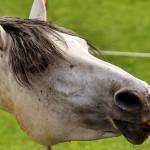Historical Feedstuffs for Horses: Carrots

Carrots are fed to horses as treats, rewards, and appetite stimulants, but how did this simple, everyday vegetable come to play a role in the diets of modern horses?
Recommendations for adding carrots to the diets of horses do not start appearing in books until the 1800s. According to the “History of Carrots”, the vegetable did not become an inexpensive and widely accessible food until the Victorian era, even though it was developed and cultivated for human consumption in the Netherlands in the 16th century. As documented in numerous books from the early 1800s and later, horsemen fed carrots to horses as a way to prevent or alleviate various ailments.
Many of these old texts describe the value of feeding carrots. In The Encyclopaedia of the Stable, published in 1909, Vero Shaw boasts that “carrots are a most excellent food for horses, and the best of all roots for animals in hard work. All horses like them, and many a shy feeder will be tempted to eat a carrot when he will refuse all other food.” The other roots Shaw alludes to likely include potatoes, rutabagas, turnips, and parsnips, all of which were also frequently fed to horses in that period.
The Pocket Farrier, from 1844, explains that “carrots are sometimes used as an article of diet, and may be given in moderate quantity, with great advantage to horses that are thick-winded, have coughs, or are disposed to inflammatory complaints, such as grease, inflamed eyes, etc. They appear to be easy of digestion and very nutritious.” This recommendation for feeding carrots to “thick-winded” horses, or those with respiratory disease, threads its way through many 19th century writings. “Grease” refers to any disease that affects the heels of the horse, usually inflammation of sebaceous follicles.
Other writers proved more tepid in their enthusiasm for carrots. In The Farmer’s Practical Horse Farriery, published in 1857, Ephraim Nash sums up the feeding of carrots in this way: “The virtues of this root are not sufficiently known, whether as contributing to the strength and endurance of the sound horse, or the rapid recovery of the sick one.”
Prolific writer Capt. M. Horace Hayes mentioned carrots in his book Stable Management and Exercise, first released at the turn of the 20th century. According to him, “a regular supply of carrots or green food is much better for horses than bran mashes.” Moreover, he explains that “while roots and fruit cannot replace the hay and corn necessary for working horses, they are a very useful addition to the equine diet. To avoid purging the horse, and unduly distending his stomach, we may accept 10 lb (4.5 kg) as a maximum quantity of such food. Carrots are the only kind I have used to such a large extent, although I have employed all the others as dainties for horses. Parsnips are supposed to be the next best roots to carrots.”
Curiously, Magner places constraints on when carrots should be fed. “Carrots are a good laxative and alterative before frost, but are too cold and constipating during cold weather. They may be fed in October, November and December, but in the Northern states no later.” Released in 1870, Magner’s publication was given this long-drawn title: The New System of Educating Horses Including Instructions on Feeding, Watering, Etc. and How Shoeing Should Be Done; with Simple Practical Treatment for Diseases Illustrated Including a Large Number of Valuable Recipes Not Before Published.
In the same vein, Lawson suggested in 1829 that carrots “are either given in spring or autumn to high-fed horses, as a change of diet, at the rate of one feed per day in the lieu of a feed of corn, or as full subsistence to others.” More of Lawson’s recommendations can be found in Modern Farrier: Or the Best Mode of Preserving the Health and Curing the Disorders of Domestic Animals with Practical Instructions to Sportsmen.
Further, cavalrymen often considered carrots appropriate substitution for forage during shortages of green grass, according to Lt. Gen. Sir Fitzwygram. In his book Horses and Stables (1894), he wrote, “Carrots are often very acceptable to sick horses and are especially valuable at those seasons of the year when fresh grass cannot be procured. They may be given by themselves or mixed with oats or mash. But the sick horse, whose appetite is very capricious, will more often be tempted by the carrot alone. For the delicate feeder…carrots or green forage may be substituted for hay, or mixed with the hay.”








